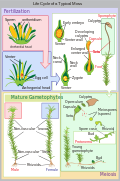Moss
Moss is a type of small, non-vascular plant that is part of the division Bryophyta. Mosses are typically found in damp or shady locations, although they can grow in a variety of habitats. They play a vital role in the ecosystem, helping to prevent soil erosion and providing a habitat for numerous species.
Characteristics[edit]
Mosses are small, soft plants that are typically 1–10 cm (0.4–4 in) tall, though some species are much larger. They commonly grow close together in clumps or mats in damp or shady locations. They do not have flowers or seeds, and their simple leaves cover the thin wiry stems.
Classification[edit]
Mosses are classified in the division Bryophyta, which is split into several classes, including Bryopsida, Sphagnopsida, and Andreaeopsida. These classes are further divided into orders, families, genera, and species.
Ecology[edit]
Mosses play a crucial role in the ecosystem. They help to prevent soil erosion by absorbing water and binding the soil together. They also provide a habitat for numerous species, including insects, amphibians, and microorganisms.
Uses[edit]
Mosses have been used by humans for a variety of purposes. They have been used as insulation, for bedding, and in horticulture. Some species of moss are also used in traditional medicine.
See also[edit]
References[edit]
<references />
External links[edit]
|
|
|
Moss[edit]
-
Tionesta ac moss
-
Bryum capillare leaf cells
-
Moss leaf under microscope
-
Lifecycle moss svg diagram
-
Moss Gametophytes Sporophytes
-
Haeckel Muscinae
-
Red Moss
-
Mossopolis
-
Moss Forest
-
Route 1, Between Vik and Kirkjubæjarklaustur
-
Moss (Iceland)
-
Steinerne Rinne bei Obererasbach im Altmühltal
Ad. Transform your life with W8MD's Budget GLP-1 injections from $75


W8MD offers a medical weight loss program to lose weight in Philadelphia. Our physician-supervised medical weight loss provides:
- Weight loss injections in NYC (generic and brand names):
- Zepbound / Mounjaro, Wegovy / Ozempic, Saxenda
- Most insurances accepted or discounted self-pay rates. We will obtain insurance prior authorizations if needed.
- Generic GLP1 weight loss injections from $75 for the starting dose.
- Also offer prescription weight loss medications including Phentermine, Qsymia, Diethylpropion, Contrave etc.
NYC weight loss doctor appointmentsNYC weight loss doctor appointments
Start your NYC weight loss journey today at our NYC medical weight loss and Philadelphia medical weight loss clinics.
- Call 718-946-5500 to lose weight in NYC or for medical weight loss in Philadelphia 215-676-2334.
- Tags:NYC medical weight loss, Philadelphia lose weight Zepbound NYC, Budget GLP1 weight loss injections, Wegovy Philadelphia, Wegovy NYC, Philadelphia medical weight loss, Brookly weight loss and Wegovy NYC
|
WikiMD's Wellness Encyclopedia |
| Let Food Be Thy Medicine Medicine Thy Food - Hippocrates |
Medical Disclaimer: WikiMD is not a substitute for professional medical advice. The information on WikiMD is provided as an information resource only, may be incorrect, outdated or misleading, and is not to be used or relied on for any diagnostic or treatment purposes. Please consult your health care provider before making any healthcare decisions or for guidance about a specific medical condition. WikiMD expressly disclaims responsibility, and shall have no liability, for any damages, loss, injury, or liability whatsoever suffered as a result of your reliance on the information contained in this site. By visiting this site you agree to the foregoing terms and conditions, which may from time to time be changed or supplemented by WikiMD. If you do not agree to the foregoing terms and conditions, you should not enter or use this site. See full disclaimer.
Credits:Most images are courtesy of Wikimedia commons, and templates, categories Wikipedia, licensed under CC BY SA or similar.
Translate this page: - East Asian
中文,
日本,
한국어,
South Asian
हिन्दी,
தமிழ்,
తెలుగు,
Urdu,
ಕನ್ನಡ,
Southeast Asian
Indonesian,
Vietnamese,
Thai,
မြန်မာဘာသာ,
বাংলা
European
español,
Deutsch,
français,
Greek,
português do Brasil,
polski,
română,
русский,
Nederlands,
norsk,
svenska,
suomi,
Italian
Middle Eastern & African
عربى,
Turkish,
Persian,
Hebrew,
Afrikaans,
isiZulu,
Kiswahili,
Other
Bulgarian,
Hungarian,
Czech,
Swedish,
മലയാളം,
मराठी,
ਪੰਜਾਬੀ,
ગુજરાતી,
Portuguese,
Ukrainian















